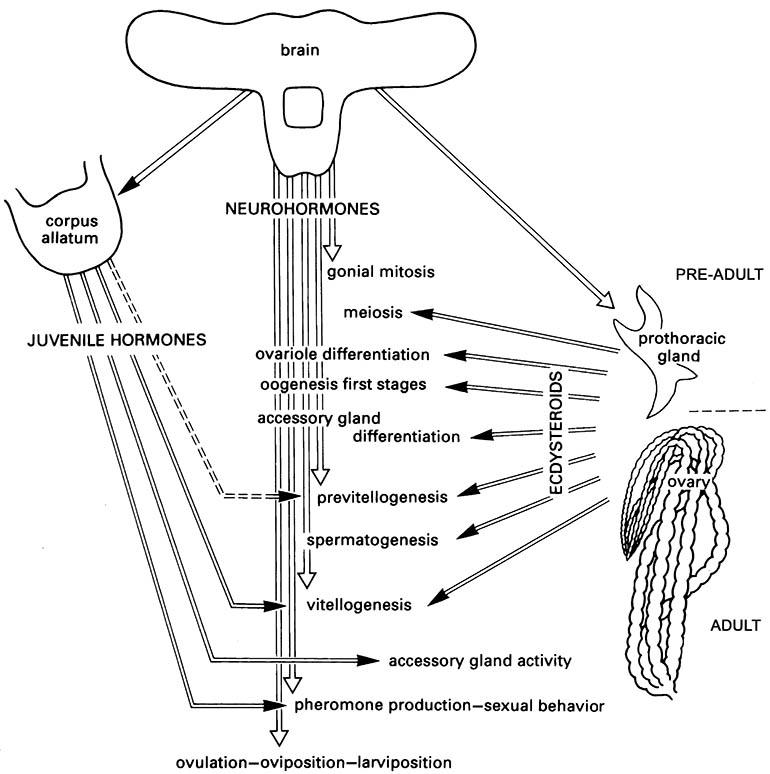5.11. Physiological control of reproduction
The initiation and termination of some reproductive events often depend on environmental factors, such as temperature, humidity, photoperiod, or availability of food or a suitable egg-laying site. Additionally, these external influences may be modified by internal factors such as nutritional condition and the state of maturation of the oocytes. Copulation also may trigger oocyte development, oviposition, and inhibition of sexual receptivity in the female via enzymes or peptides transferred to the female reproductive tract in male accessory gland secretions (Box 5.4).
Fertilization following mating normally triggers embryogenesis via egg activation (Chapter 6). Regulation of reproduction is complex and involves sensory receptors, neuronal transmission, and integration of messages in the brain, as well as chemical messengers (hormones) transported in the hemolymph or via the nerve axons to target tissues or to other endocrine glands. Certain parts of the nervous system, particularly neuro-secretory cells in the brain, produce neurohormones or neuropeptides (proteinaceous messengers) and also control the synthesis of two groups of insect hormones — the ecdysteroids and the juvenile hormones (JH). More detailed discussions of the regulation and functions of all of these hormones are provided in Chapters 3 and 6. Neuropeptides, steroid hormones, and JH all play essential roles in the regulation of reproduction, as summarized in Fig. 5.13.
Juvenile hormones and/or ecdysteroids are essential to reproduction, with JH mostly triggering the functioning of organs such as the ovary, accessory glands, and fat body, whereas ecdysteroids influence morphogenesis as well as gonad functions. Neuropeptides play various roles at different stages of reproduction, as they regulate endocrine function (via the corpora allata and prothoracic glands) and also directly influence reproductive events, especially ovulation and oviposition or larviposition.
The role of neuropeptides in control of reproduction (Table 3.1) is an expanding area of research, made possible by new technologies, especially in biochemistry and molecular biology. To date, most studies have concentrated on the Diptera (especially Drosophila, mosquitoes, and houseflies), the Lepidoptera (especially the tobacco hornworm, Manduca sexta), locusts, and cockroaches.
Table 3.1. Examples of some important insect physiological processes mediated by neuropeptides.
(After Keeley & Hayes 1987; Holman et al. 1990; Gäde et al. 1997; Altstein 2003.)
| Neuropeptide | Action |
|---|---|
| Growth and development | |
| Allatostatins and allatotropins | Induce/regulate juvenile hormone (JH) production |
| Bursicon | Controls cuticular sclerotization |
| Crustacean cardioactive peptide (CCAP) | Switches on ecdysis behavior |
| Diapause hormone (DH) | Causes dormancy in silkworm eggs |
| Pre-ecdysis triggering hormone (PETH) | Stimulates pre-ecdysis behavior |
| Ecdysis triggering hormone (ETH) | Initiates events at ecdysis |
| Eclosion hormone (EH) | Controls events at ecdysis |
| JH esterase inducing factor | Stimulates JH degradative enzyme |
| Prothoracicotropic hormone (PTTH) | Induces ecdysteroid secretion from prothoracic gland |
| Puparium tanning factor | Accelerates fly puparium tanning |
| Reproduction | |
| Antigonadotropin (e. g. oostatic hormone, OH) | Suppresses oocyte development |
| Ovarian ecdysteroidogenic hormone (OEH = EDNH) | Stimulates ovarian ecdysteroid production |
| Ovary maturing peptide (OMP) | Stimulates egg development |
| Oviposition peptides | Stimulate egg deposition |
| Prothoracicotropic hormone (PTTH) | Affects egg development |
| Pheromone biosynthesis activating neuropeptide | Regulates pheromone production (PBAN) |
| Homeostasis | |
| Metabolic peptides (= AKH/RPCH family) | |
| Adipokinetic hormone (AKH) | Releases lipid from fat body |
| Hyperglycemic hormone | Releases carbohydrate from fat body |
| Hypoglycemic hormone | Enhances carbohydrate uptake |
| Protein synthesis factors | Enhance fat body protein synthesis |
| Diuretic and antidiuretic peptides | |
| Antidiuretic peptide (ADP) | Suppresses water excretion |
| Diuretic peptide (DP) | Enhances water excretion |
| Chloride-transport stimulating hormone | Stimulates Cl− absorption (rectum) |
| Ion-transport peptide (ITP) | Stimulates Cl− absorption (ileum) |
| Myotropic peptides | |
| Cardiopeptides | Increase heartbeat rate |
| Kinin family (e. g. leukokinins and myosuppressins) | Regulate gut contraction |
| Proctolin | Modifies excitation response of some muscles |
| Chromatotropic peptides | |
| Melanization and reddish coloration hormone (MRCH) | Induces darkening |
| Pigment-dispersing hormone (PDH) | Disperses pigment |
| Corazonin | Darkens pigment |

The transition from ecdysterone production by the pre-adult prothoracic gland to the adult ovary varies between taxa. (After Raabe 1986)

